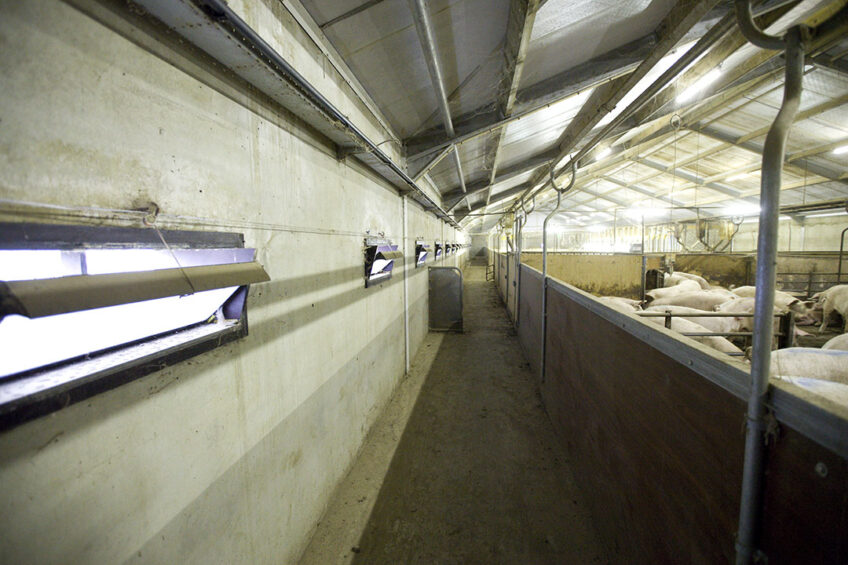How to achieve proper air quality in the swine barn

To maintain good air quality in pig barns, swine producers need to devote time and resources to manage barn conditions. In addition, it is necessary to balance the environmental conditions in the barn according to the age of the pigs, their health status, breed, and growth rate. What should the air quality characteristics in the swine barn be? How can ventilation systems be applied to optimise swine health and welfare?
As the swine industry continues to grow, gases such as ammonia, hydrogen sulfide and carbon dioxide and odours cntinue to have a negative impact on air quality, animal health, and the environment.
Optimal barn conditions
Preserving optimal barn conditions is thus essential for pig growth, productivity, and welfare. Proper ventilation provides fresh air, decreases humidity, lowers dust levels, prevents formation of ammonia and hydrogen sulphide, increases overall feed intake, and reduces pigs’ respiratory challenges and mortality.
What is ventilation?
Ventilation is defined as a process that dilutes inside air with the mixing of fresh outside air. It brings in oxygen, ousts harmful dusts, gases, undesirable odors, airborne organisms, and moisture from the pigs. The ventilation system affects air temperature, moisture level, surface moisture concentration, air temperature uniformity, air speed across animals, and airborne dust and gases.
Indoor air quality characteristics
Proper space temperature is essential for swine health, welfare, and performance. This is the case especially for pigs that are more susceptible to cool temperatures. Relative humidity, which compares the relative percentage of moisture in the air to how much moisture the air could potentially hold at the same temperature is critical during the heating season, as well.
Ventilation systems in swine barn
2 types of ventilation systems are suitable for swine barns: mechanical and natural. A mechanical ventilation system forces air through the building with fans using negative, positive, or neutral pressure.
A negative pressure system forces the outside air flow into the barn via inlets and pushes air out by fans. A positive pressure system forces outside air flow into the barn via fans. A neutral pressure system uses fans to push outside air into the barn through a duct. Exhaust fans pull stale air out of the barn.
Mechanical ventilation system are suitable for farrowing and nursery pigs to control air temperature during winter and summer. On the other hand, natural ventilation relies on animal heat to warm the building and the dry outdoor environment to remove moisture from the barn. This system is suitable for older pigs who can retain their own body heat and withstand colder temperatures.
The ideal location for natural ventilation system would be on higher ground with no obstructions to disturb airflow around or through the barn.
Properties of a suitable ventilation system
A well controlled ventilation system maintains proper temperature and humidity levels, limits moisture accumulation in winter, and restricts heat rise in summer. Ventilation fan stages need to match the air flow to balance the heat and moisture produced in the barn.
When pigs grow, they produce more heat and moisture; therefore, the facility ventilation rate need to increase through the growing period. In addition, the difference between indoor and outdoor temperature and humidity affects ventilation requirements and the staging of fans.
Inlets are commonly used in negative pressure barns. Inlets’ location, size, barn width, air intake during cold and hot weather, and air entering across barn ceiling versus down the side walls are important traits for proper ventilation. Furthermore, the total inlet area, spacing between inlets, and air speed impact the static pressure, air velocity, and appropriate air mixing, and prevent drafts and dead air pockets within the barn.
Concluding remarks
Swine producers need to consider various parameters such as outdoor temperature and humidity to make decisions about ventilation systems. Advancement of technology however, leads to more complex and challenging ventilation management in swine barns. Thus, further research can evaluate ventilation problems and their potential causes to improve on-farm ventilation systems.
 Beheer
Beheer




 WP Admin
WP Admin  Bewerk bericht
Bewerk bericht